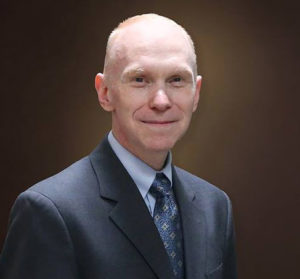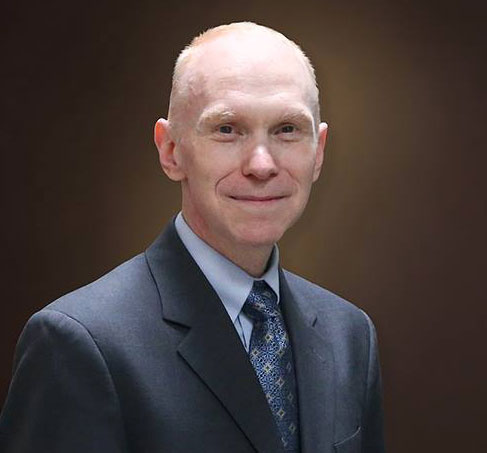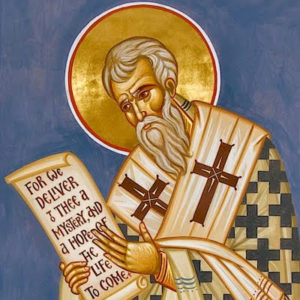Podcast: Play in new window | Download (Duration: 28:39 — 19.8MB) | Embed
Subscribe: Apple Podcasts | Spotify | Amazon Music | Android | Pandora | iHeartRadio | JioSaavn | Podchaser | Gaana | Podcast Index | Email | TuneIn | Deezer | Anghami | RSS | More
St. Cyril of Jerusalem – The Doctors of the Church with Dr. Matthew Bunson

- Born: 313 AD, Caesarea Maritima, Israel
- Died: March 18, 386 AD, Jerusalem, Israel
Dr. Matthew Bunson discusses St. Cyril of Jerusalem, recognized as a Doctor of the Church by Pope Leo XIII in 1883. St. Cyril, born around 315 AD, witnessed Jerusalem’s transformation into a Christian center under Constantine the Great and his mother, St. Helena.
Despite his humble and moderate nature, he faced challenges, including being falsely accused of supporting the Arian heresy by Bishop Acacius. St. Cyril’s time as Bishop of Jerusalem was marked by jurisdictional disputes and three exiles due to political and theological conflicts.
His enduring legacy lies in his catechetical lectures, particularly his mystagogical teachings on baptism, Eucharist, and prayer, which hold relevance for modern Christian formation and the new evangelization. St. Cyril’s gentle approach to dialogue and his commitment to orthodoxy amid controversy serve as a model for fostering unity and understanding within the Church.
Discerning Hearts Reflection Questions
- St. Cyril of Jerusalem’s Recognition as a Doctor of the Church: How does the late recognition of St. Cyril as a Doctor of the Church by Pope Leo XIII reflect a broader emphasis on Eastern Church figures and early Church history during that time?
- St. Cyril’s Background and Early Life in Jerusalem: Reflect on the significance of St. Cyril’s upbringing in Jerusalem amidst its transformation into a Christian center under Constantine the Great and St. Helena. How might this context have influenced his faith and teachings?
- Challenges and Controversies Faced by St. Cyril: St. Cyril faced false accusations and political conflicts, particularly regarding the Arian heresy and jurisdictional disputes. How did his response to these challenges demonstrate his commitment to orthodoxy and unity within the Church?
- St. Cyril’s Contributions to Catechesis: Consider the format and content of St. Cyril’s catechetical lectures. How do his teachings on baptism, Eucharist, and prayer provide a framework for Christian formation and ongoing spiritual growth?
- The Significance of Mystagogy and its Relevance Today: Reflect on the importance of mystagogical catechesis, particularly in post-baptismal formation. How can the Church reclaim and integrate this aspect into contemporary catechetical programs?
- St. Cyril’s Approach to Dialogue and Unity: St. Cyril’s moderate and gentle nature allowed him to engage in dialogue and seek unity within the Church despite theological differences. How can his example guide us in fostering understanding and reconciliation in modern-day theological debates?
- The Sacred Context of St. Cyril’s Teachings: Visualize St. Cyril delivering his catechetical lectures in the sacred setting of Jerusalem. How might the historical and spiritual significance of this location have influenced the delivery and reception of his teachings?
- Personal Reflection on St. Cyril’s Legacy: Reflect on the enduring impact of St. Cyril’s life and teachings. How does his example inspire us to deepen our own faith and engage in the mission of the Church today?
For more on St. Cyril and his teachings:
St. Cyril of Jerusalem – Catechetical Lectures
From Vatican.va, an excerpt from the teachings of Pope Benedict XVI General Audience 2007:
“Taken as a whole, Cyril’s homilies form a systematic catechesis on the Christian’s rebirth through Baptism.
He tells the catechumen: “You have been caught in the nets of the Church (cf. Mt 13: 47). Be taken alive, therefore; do not escape for it is Jesus who is fishing for you, not in order to kill you but to resurrect you after death. Indeed, you must die and rise again (cf. Rom 6: 11, 14)…. Die to your sins and live to righteousness from this very day” (Procatechesis, 5).
From the doctrinal viewpoint, Cyril commented on the Jerusalem Creed with recourse to the typology of the Scriptures in a “symphonic” relationship between the two Testaments, arriving at Christ, the centre of the universe.
The typology was to be described decisively by Augustine of Hippo: “In the Old Testament there is a veiling of the New, and in the New Testament there is a revealing of the Old” (De catechizandis rudibus 4, 8).
As for the moral catechesis, it is anchored in deep unity to the doctrinal catechesis: the dogma progressively descends in souls who are thus urged to transform their pagan behaviour on the basis of new life in Christ, a gift of Baptism.
The “mystagogical” catechesis, lastly, marked the summit of the instruction that Cyril imparted, no longer to catechumens but to the newly baptized or neophytes during Easter week. He led them to discover the mysteries still hidden in the baptismal rites of the Easter Vigil.
Enlightened by the light of a deeper faith by virtue of Baptism, the neophytes were at last able to understand these mysteries better, having celebrated their rites.”
For more visit Vatican.va
For more from Dr. Matthew Bunson, check out his Discerning Hearts page.
Dr. Matthew E. Bunson is a Register senior editor and a senior contributor to EWTN News. For the past 20 years, he has been active in the area of Catholic social communications and education, including writing, editing, and teaching on a variety of topics related to Church history, the papacy, the saints and Catholic culture. He is faculty chair at Catholic Distance University, a senior fellow of the St. Paul Center for Biblical Theology, and the author or co-author of over 50 books including The Encyclopedia of Catholic History, The Pope Encyclopedia, We Have a Pope! Benedict XVI, The Saints Encyclopedia and best-selling biographies of St. Damien of Molokai and St. Kateri Tekakwitha.



